Think you just scored a pair of $160 Nikes for $19.99? You’re not that lucky. Scammers are peddling unbelievable flash sales on coveted kicks via targeted ads on Facebook, Instagram and TikTok. But it’s an elaborate ruse designed to steal your money and data. This in-depth article exposes how this “too good to be true” scam works, and how to avoid becoming its next victim.

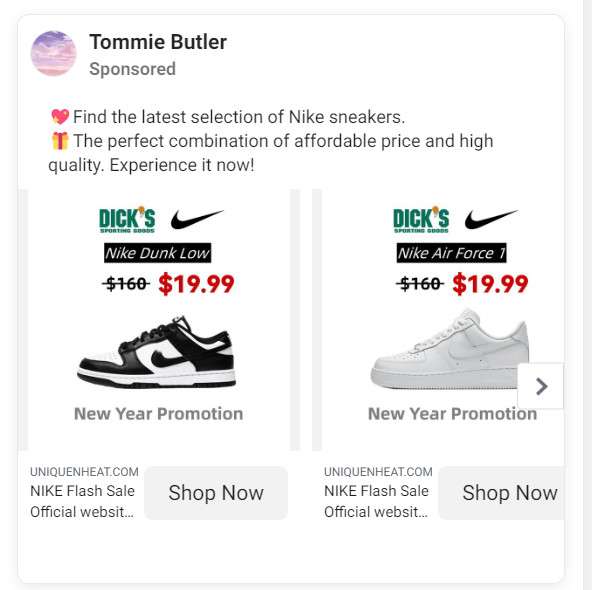
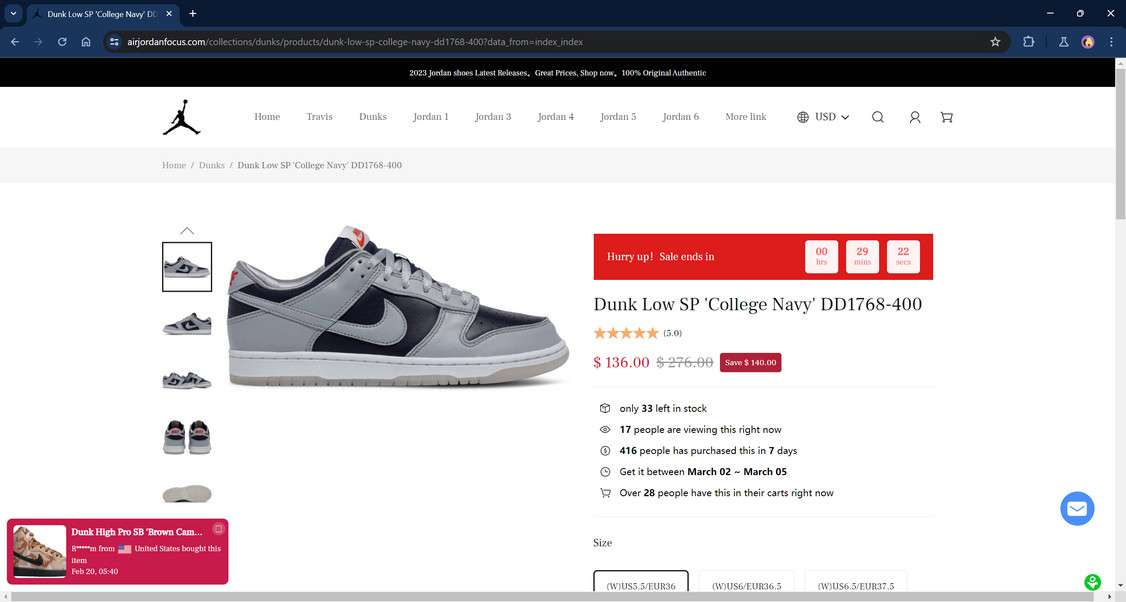
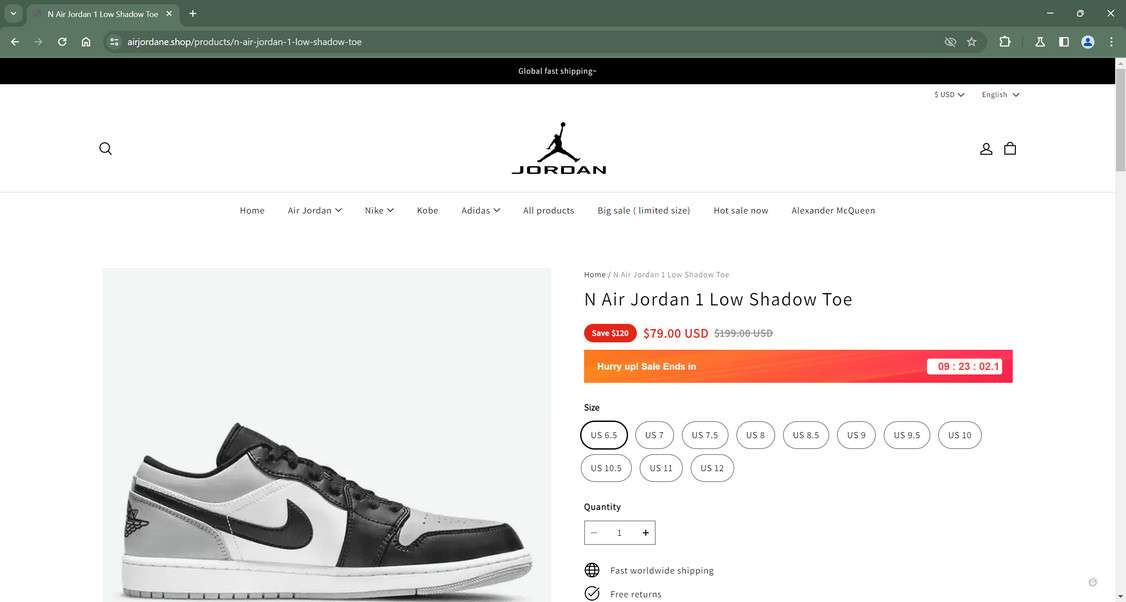
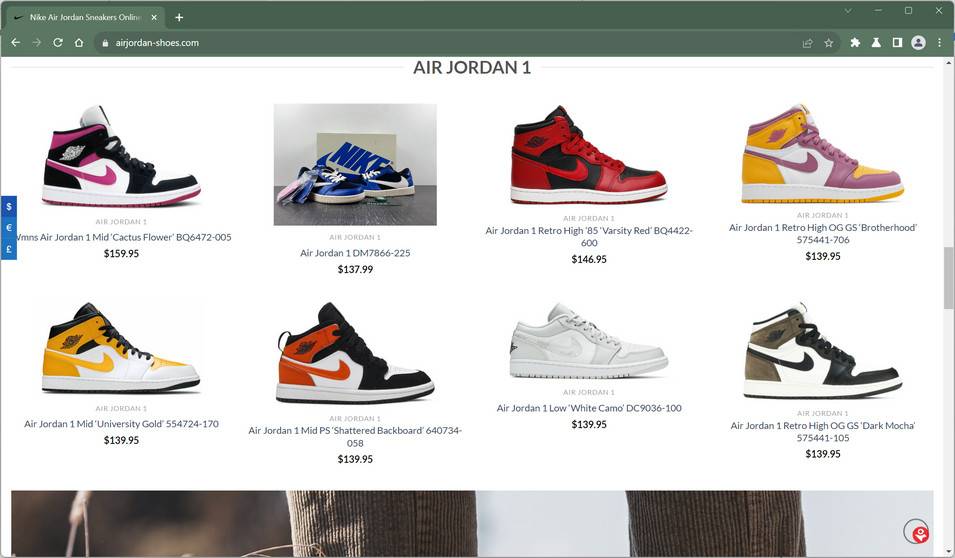
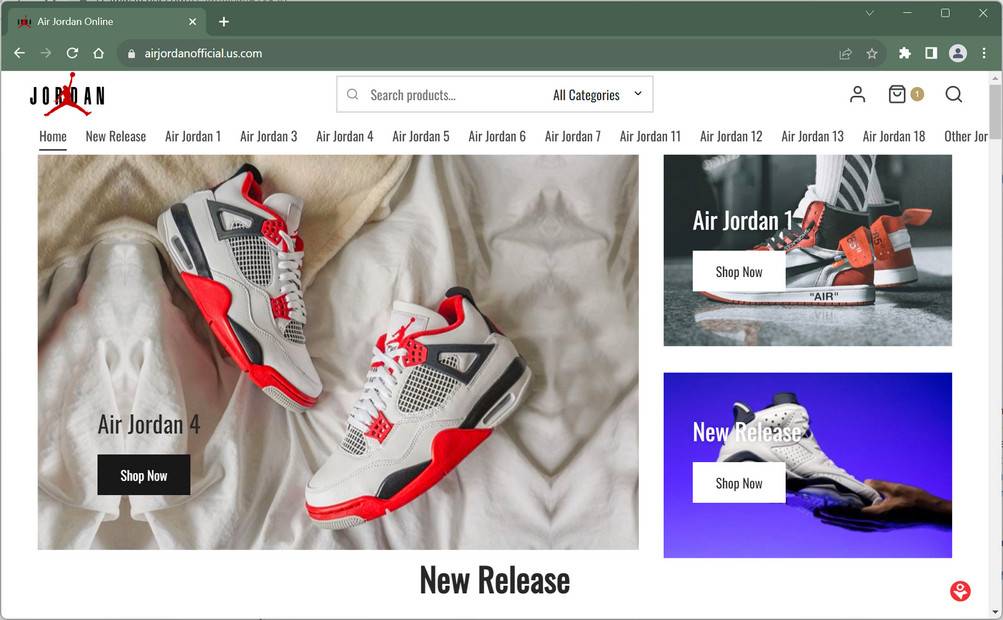
Overview of the $19.99 Nike Flash Sale Scam Spreading Across Social Media
This cunning scam exploits the reputation of Nike and major retailers by promoting fake flash sales with unreal 90% discounts on coveted shoes like Air Jordans and Nike Dunks. Scammers blast out targeted ads on Facebook, Instagram and TikTok touting these unbelievable deals to lure in victims.
For example, an ad may read “Nike Flash Sale! Air Jordans Just $19.99 Today Only!” or “Hurry – Nike Dunks $39.99 Before They Sell Out!”. The ads also frequently impersonate reputable retailers like Dick’s Sporting Goods, Foot Locker, and Macy’s without authorization by using their official logos and branding.
Clicking these compelling flash sale promotions leads shoppers not to Nike.com or real retailer sites, but rather to sophisticated fake e-commerce sites. These scam stores are meticulously designed to mimic the look, feel and navigation of real Nike and retailer websites using stolen branding assets, photos and content.
The scam sites accept payment info and process orders, but no products are ever fulfilled. After submitting their personal and credit card information, victims soon realize it’s a scam when no confirmation email appears. At that point the damage is done, as scammers immediately utilize stolen data to make fraudulent purchases online or resell it on dark web markets.
These sham Nike flash sale promotions prey on shopper psychology using a variety of manipulative tactics:
- Touting enviable discounts up to 90% off retail prices. For instance, $160 Nike shoes slashed to just $19.99 or $29.99. These unbelievable prices disable critical thinking.
- Promising limited-time flash sales with scarcity warnings like “Almost Gone!” to trigger impulsive purchases before deeper inspection.
- Displaying fake trust badges, security seals, and satisfaction guarantees to boost site credibility.
- Fabricating positive customer reviews since real ratings would expose the scam.
- Including no company contact information to avoid easy fraud reporting.
- Registering domains with typos like nikestoreonlne.com to deceive visitors.
In addition to credit card theft, users’ stolen personal information like names, emails and addresses can be sold on black markets and used for identity theft. Scammers capitalize as much as possible before sites get flagged, then quickly launch new domains and ads to repeat the process.
Without scrutinizing carefully, it’s easy to fall victim when a coveted $160 pair of Nikes is advertised at an unbelievable $19.99 price point. But telltale signs beneath the surface reveal the true scam nature.
Red flags to watch for include:
- Absurd discounts over 90% off retail prices that brands never offer.
- High-pressure tactics urging immediate purchase before imaginary sales end.
- Domains registered this year when brands are decades old.
- Improper spelling, grammar, and other amateur site elements.
- Disabled features like reviews, security seals, and contact pages.
- Generic descriptions and specs that indicate counterfeit products.
When evaluating online deals that seem too good to be true, take time to carefully analyze site details instead of jumping on the deal. For high-demand brands like Nike, verify discounts on the official company website or authorized retailer sites that have been safely shopped for years.
Avoid following links in social ads directly to unknown sites, regardless of how compelling the sale promotions might appear. With vigilance and awareness, shoppers can spot the manipulative tricks and enjoy peace of mind steering clear of flash sale scams.
How the $19.99 Nike Flash Sale Scam Works to Deceive Shoppers
This intricate fraud relies on precise emotional manipulation and elaborate website spoofing to extract unsuspecting users’ sensitive data. Let’s examine the systematic approach scammers use to successfully pull off the fake Nike flash sale scam step-by-step:
Step 1. Create Compelling Flash Sale Ads for Coveted Nike Shoes
Scammers design targeted social media ads promoting the flash sales using real Nike shoes images and envy-inducing discounts like “Air Jordans Just $19.99!” and “Last Chance! Nike Dunks $39.99!”. The unbelievable prices disable critical thinking.
Step 2. Disguise Scam Ads as Authorized Retailers
To boost credibility, scam ads also frequently impersonate authorized retailers like Dick’s, Foot Locker and Macy’s by including their official logos without consent. This exploits consumer trust in those well-known brands.
Step 3. Blast Ads Targeting Sneaker Enthusiasts on Social Media
The scam ads get blasted on platforms like Facebook, Instagram and TikTok using interests like “sneaker deals”, “Jordans”, “Dunks” to reach huge swaths of users inclined to fall for the fake deals.
Step 4. Drive Clicks to Elaborate Fake Storefronts Mimicking Real Sites
Users who click on the compelling ads get taken not to Nike.com or real retailer sites, but rather directly to sophisticated scam stores mimicking those sites. Everything from branding to layouts are precisely spoofed.
Step 5. Add Urgency Tactics Like Countdown Timers on the Fake Sites
The scam sites display countdown timers, limited inventory warnings and other fake scarcity tactics urging immediate purchase. This prevents visitors from inspecting sites in detail.
Step 6. Utilize Trust Badges, Security Seals and Guarantees
To boost perceived credibility, scam sites feature stolen trust logos and satisfaction guarantees as well as fake security seals like McAfee SECURE and Norton Verified.
Step 7. Fabricate Positive Customer Reviews and Ratings
Since real reviews would expose them, scammers instead fabricate tons of 5-star ratings and glowing customer comments to boost scam site trustworthiness.
Step 8. Make Checkout Process Seamless to Finalize Data Theft
Site checkout flows are heavily streamlined to ensure users complete purchases swiftly. This allows visitor payment and personal information to be extracted before defects get noticed.
Step 9. Never Ship Any Products After Processing Payments
With users’ sensitive data stolen, scammers disappear without shipping anything. The visitor only realizes the scam after no confirmation email appears post-purchase.
Step 10. Immediately Monetize Stolen Data for Fraudulent Purchases
Scammers quickly utilize stolen credit cards and personal information for fraudulent purchases and transactions before the data gets flagged and cards are cancelled.
Step 11. Sell Stolen Data to Other Criminals on Dark Web Markets
In addition to using it directly, scammers also sell victims’ stolen data on dark web markets at a profit to maximize revenue from each scam.
Step 12. Launch New Sites and Ads to Rinse and Repeat
Before getting shut down, scammers launch new scam sites and ads to maximize victims. Then the process repeats with fresh websites and promotions to continually dupe social media users.
This complex process maximizes manipulation and deceit at every phase to successfully convert visitors into victims. Only later does the realization set in that coveted Nike shoes were never going to ship. But by then, the damage is done through stolen identities, credit card fraud and sales of personal data on black markets.
The multi-layered approach combines social engineering, precise site spoofing, emotional triggers and urgency to disable critical thinking and rational scrutiny. But awareness of how each deceitful piece fits together enables online shoppers to recognize these too-good-to-be-true scams before getting duped.
Red Flags: How to Spot the $19.99 Nike Flash Sale Scam
While the fake sites lookconvincing, a close inspection reveals many red flags exposing their fraudulent nature. Here are the telltale signs it’s a sham:
- Unreal Flash Sale Pricing – Authentic brands rarely offer discounts over 25-30%, let alone 90%+ off — yet the scam ads promise $160 shoes for $19.99.
- High-Pressure Tactics – Countdown timers, limited stock warnings and other urgency tactics are used to prevent closer inspection.
- Suspicious Domains – Sites use new domains with typos or extra words meant to mimic real URLs. Ex: nikestoreonline.com.
- No Verified Contact Info – Scam sites lack working phone numbers, addresses or customer service options to avoid fraud reports.
- No Real Customer Reviews – Unlike authentic stores, all reviews are fake or disabled to conceal suspicions.
- Invalid SSL Certificates – Lack of HTTPS encryption exposes the sham checkout pages. No secure padlock icon.
- Amateur Site Design – Sloppy designs with low-res images, grammar errors and missing info betray the forgeries.
- Aggressive Upselling – Pressuring visitors to buy more overpriced accessories exposes the true intent.
Stay vigilant for these red flags when evaluating limited-time sales promotions online. Take time to analyze sites instead of jumping on deals that seem too good to be true.
How To Spot the Nike Flash Sale Scam on Social Media
How to Identify the Scam Ads on Facebook
Watch for these red flags when evaluating Facebook ads promoting unbelievable Nike flash sales:
- Prices too good to be true – like 90% off coveted shoes (Air Jordans for $19.99).
- High pressure tactics and fabricated urgency – “Today Only!” “Almost Gone!”.
- Enticing slogans – “Warehouse Clearance Sale” or “Store Closing Sale”.
- Links go to shady new domains instead of Nike.com or authorized retailers.
- Uses AI-generated fake celebrity or influencer endorsements in ad creative.
- Comments full of fake engagement and bots, not real users.
- Sponsored by opaque Facebook pages, not official brand accounts.
Scrutinize for these signs of fakery, and avoid following links in the ads to unknown sketchy sites. Stick to deals offered through Nike’s official Facebook page and verified retailer pages.
How to Spot the Scam on Instagram
Look for these Instagram scam giveaways when inspecting flash sale promotions:
- Incredibly low prices like Air Jordans for just $29.99.
- High-pressure tactics like “Going fast!” or “Today only!”.
- Enticing slogans in captions – “Blowout Sale” or “Clearance Event”.
- Tagged with hypebeast hashtags like #sneakerhead #jordans but no brand tags.
- New Instagram accounts with few real followers or engagement.
- Uses fake vouches by nonexistent sneaker experts in captions.
- Links in bio go to shady new domains, not real sites.
Carefully scrutinize handles, account ages, and domains before engaging with Instagram flash sale promotions. Avoid providing any info or clicking links.
Identifying the TikTok Flash Sale Scam Ads
Watch for these signals when assessing flash sale promotions on TikTok:
- Air Jordans advertised at absurd prices like $19.99 or $39.99.
- High-pressure captions – “Hurry, almost gone!” or “Today only!”.
- Enticing slogans – “Blowout sale” or “Nike Warehouse Clearance”.
- Video shows fake animated Nike shoes, not real footage.
- Brand new accounts with limited followers/engagement pushing the deals.
- Comment sections full of fake bot accounts astroturfing interest.
- Links in bios go to shady new domains, not real shoe sites.
Analysis of account details, site links, and engagement metrics can help expose the fakes. Stay far away from sketchy TikTok deals using unbelievable prices and manipulative slogans.
What to Do If You Fall Victim to the Fake Nike Flash Sale Scam
If you suspect you were duped by one of these sham Nike flash sale promotions, take the following steps to limit damages:
1. Contact banks to block any fraudulent charges
Alert credit card providers and banks immediately of any unauthorized transactions. Freeze accounts as needed to prevent further abuse.
2. Place fraud alerts and monitor your credit reports
Notify credit bureaus to flag your reports. Check reports regularly for any suspicious new accounts opened in your name.
3. Reset passwords and enable two-factor authentication
Change passwords on all accounts that used the compromised email/password combination. Enable 2FA for an added layer of security.
4. Watch out for recovery scams
Scammers often exploit victims further by contacting them pretending to be able to recover lost money, for an upfront fee. Avoid engaging with any of these secondary scams.
5. File reports about the scam
Submit details on the fraudulent ads, sites and accounts to agencies like the FTC, FBI IC3, and social media platforms. This aids investigations to protect other users.
6. Learn from the experience
Understand the warning signs of online retail scams and remember if a deal seems too good to be true, it probably is. Stick to trusted retailers and double-check discounts.
Frequently Asked Questions About the Viral $19.99 Nike Flash Sale Scam
1. How do I recognize the $19.99 Nike flash sale scam ads on social media?
Watch for ads on Facebook, Instagram, and TikTok promoting Air Jordans, Dunks, or other Nike shoes for unbelievable prices like $19.99 or $29.99. They frequently use enticing slogans like “Warehouse Clearance Sale!” and high-pressure tactics like “Almost Gone!”. The ads and accounts often seem fake, lack followers, and link to sketchy websites.
2. What are examples of the scam websites the ads link to?
The ads link to sophisticated fake e-commerce sites designed to mimic the real Nike.com site. Examples include domain names like nikestoreonlline.com or nikeoutletshop.com. The sites feature Nike’s branding, images, and templates but are not the real store.
3. How do the fake sites scam users?
The sites look legitimate and allow visitors to add products to cart and enter payment information. But instead of fulfilling orders, the sites simply steal users’ credit card and personal information for fraud. No products are ever shipped out.
4. What’s the end goal of this Nike flash sale scam?
The ultimate goal is to gather users’ sensitive credit card and personal data like names, emails, and addresses. Scammers then either use this info for identity theft and fraudulent purchases, or sell it on dark web markets at a profit.
5. What should I do if I already entered my information on one of the scam sites?
Immediately contact your credit card companies and banks to report fraudulent charges or freeze accounts. Monitor your credit reports regularly for any suspicious activity. Change passwords on any compromised accounts and enable credit freezes or fraud alerts.
6. How can I safely buy real Nike shoes online?
Only purchase Nike products through Nike.com or verified authorized retail partners like Foot Locker and Dick’s Sporting Goods. Links in social media ads often lead to scam sites – go directly to real brand sites instead of clicking social links.
7. How can I report these fake Nike flash sale ads and sites?
Gather details on the ads, accounts, and websites then report them directly to platforms like Facebook, Instagram, TikTok. Also file complaints with the FTC, FBI IC3, DNS registrars, and hosting providers to expedite takedowns.
8. How can I avoid falling for similar “too good to be true” scams?
Always carefully inspect sites, discounts, domains, and other details instead of impulsively buying. Ask yourself “would a reputable brand offer new shoes at 90% off retail pricing?” If it seems unrealistic, it likely is a scam.
The Bottom Line: Stay Vigilant Against Viral Flash Sale Scams
Scammers will continue dreaming up new viral tactics and scams to improperly extract users’ money and data. But an informed public that knows how these frauds operate is the best defense. With greater awareness of the warning signs, online shoppers can avoid falling victim when they encounter unbelievable flash sales peddled through social media channels.
The prospect of scoring coveted shoes and clothing at jaw-dropping low prices will always be tempting. However, carefully researching discounts and inspecting sites can protect users from compromised accounts and stolen funds. Don’t let scammers leverage human vulnerabilities and brand reputations to successfully pull off their fake flash sale frauds.
Stay skeptical of unbelievable deals and you can confidently avoid becoming their next target. Now go flex in those legit new sneakers you actually waited and paid for fairly to obtain!










